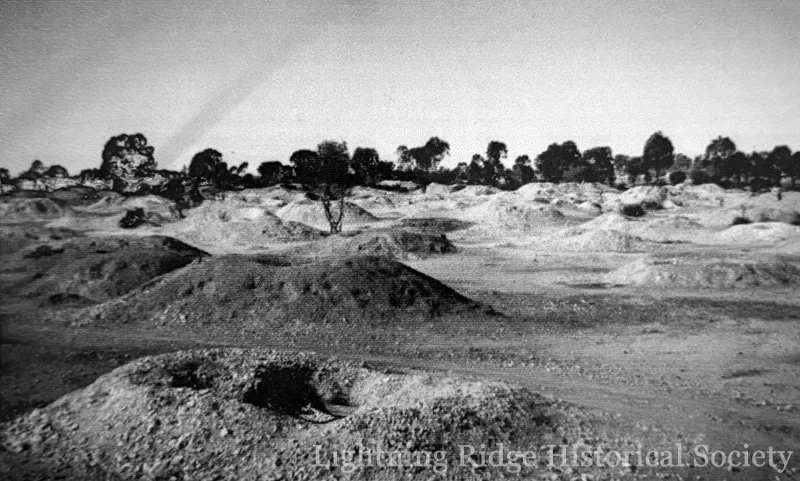Telephone Line
Telephone Line field, 1950s. Photograph: Lightning Ridge Historical Society collection.
Telephone Line (or Phone Line) is an opal field located on both sides of the old Walgett road, between Cleared Line and Dry Rush. Telephone Line is part of the Cleared Line field, inasmuch as it follows the literal cleared line, where scrub and trees were removed for infrastructure. It was named for the station telephone line that once ran westward from a Dunumbral outstation, crossing the Walgett road and continuing south through to the Three Mile. From there it continued to Ryan’s Flat tank, then through the Angledool–Dunumbral boundary fence to Tom Leonard’s hut at Nebea. Over time the line itself fell into disrepair, but the name stuck.
The field was discovered in 1913 by Tom Burrows, who had recently moved over after his luck ran out at Walshe’s. He struck opal just under the telephone line where it crossed the road, and in doing so kicked off a small rush. The ground was firm and consistent, with workings at an average depth of 40 to 45 feet with a continuous opal bearing level.
Some of Lightning Ridge’s finest black opal was found here. In one of the better-known finds, Ted “Snowy” Brown and Tom Urwin uncovered a pocket in 1914 or 1915 that yielded nine sensational stones, including The Pride of Australia (225 carats), The Empress (110 carats), and The Black Prince (130 carats), and the lesser Flamingo. The stones were dug out between two and three in the morning to avoid ratters, and were sold for £550 a large sum at the time. Mining Warden Perry deemed them of such quality that he recommended they be exhibited at the Panama-Pacific International Exposition in San Francisco.
Other miners also did well. Albert and Jack Dominick took £3,300 worth from the east side of the road. By 1967, as per The Lightning Ridge Book by Stuart Lloyd, the field’s total recorded production had reached £66,000, placing it among the more successful of the early Lightning Ridge diggings.
Article: Research by Russell Gawthorpe and Leisa Carney, edited by Russell Gawthorpe. LRHS research compiled by Len Cram and Barbara Moritz. Sources: The Lightning Ridge Book, Stuart Lloyd, 1967, pp. 70-71; Lightning Ridge - The Home of the Black Opal: Unique to the World, Gan Bruce, 1983, p. 89; The Occurrence of Opal at Lightning Ridge and Grawin, with Geological Notes on County Finch, J. W Whiting & R. E. Relph, 1958, p. 9; Discover Opals: Before and Beyond 2000 with Surface Indications, Stephen Aracic, 1996, p. 141.

